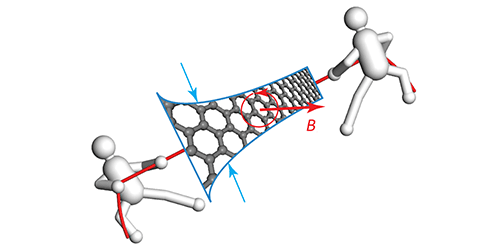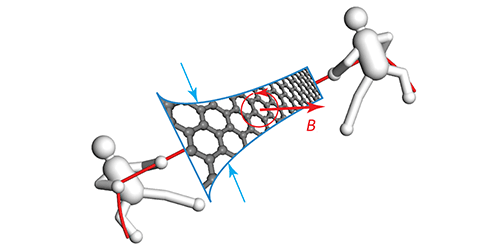Giving Graphene a Good Stretch
When graphene is strained, its electrons move as if in a strong magnetic field. This so-called pseudomagnetic effect opens up new possibilities in graphene electronics, but so far, the induced fields have been highly localized in space. A new theoretical study explains how to shape a flat graphene ribbon so that pulling on its ends produces a uniform pseudomagnetic field.
In 2010, physicists discovered that stretching the two-dimensional lattice of graphene into a triangular bubble shape caused the conduction electrons to turn in a circle, as they would in a magnetic field. These pseudomagnetic fields are strongly peaked with magnitudes as high as 300 tesla—well beyond what can be attained with stable laboratory magnets. The induced fields, if made more spatially uniform, could enable “valleytronics,” in which electrons separate into distinct valley-shaped energy bands.
One proposal for making a uniform pseudomagnetic field is to tug on a flat graphene sheet in three different directions, but this is technically challenging. A simpler method, conceived by Teng Li from the University of Maryland, College Park, and his collaborators, requires pulling along just one axis. The team imagined a flat ribbon of graphene that progressively narrows from one end to the other, like a 2D projection of a musical horn. Pulling on the ends produces a strain that steadily increases along the length of the ribbon, and this constant strain gradient gives a uniform pseudomagnetic field, as verified by the team’s numerical simulations. The field magnitude is tunable from 0 to 200 tesla by varying the stretching force. The authors are confident that nanofabrication technologies will soon be able to make their design a reality.
This research is published in Physical Review Letters.
–Michael Schirber





